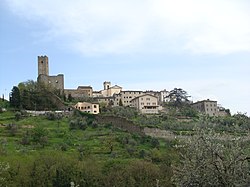History
The name of Larciano results from the latinization of the Etruscan name Larthial, which was the possessive genitive of the male name Larth. Larth is the proper name of an Etruscan fighter whose tomb, dating back to the year 340 before Christ, was discovered in 1870 in Tarquinia (a municipality in the Lazio region, Italy). In 941 the toponym was presented as Arsianus; as time passed, it was converted into its current name. Another hypothesis focuses on a "praedium" (farm), probably donated to a Roman soldier who had fought in the wars against the Ligurians and who stood out for his courage. It must be pointed out that the Italian ending of words in "ano" is typical of the Roman settlements which arose from a "praedium". Finally, a third hypothesis, even if it appears to be the least probable, states that the toponym derives from "larch" since in the past the area was rich in larch woods.
The history of Larciano is based on the history of the area named nowadays Larciano Castello.
By the middle of the tenth century, Larciano belonged to the Guidis thanks to a donation that Ranieri and Guido, Count Tegrimo's sons, made to the cathedral and to the bishop of Pistoia. Later, the castle situated in Larciano was confirmed to the Guidis by Arrigo VI and Federico II.
In 1225 the sons of Guido Guerra, who was the count of Modigliana (a municipality in the Emilia-Romagna region, Italy), sold Larciano, along with Cecina, Casi and Collecchio, to the municipality of Pistoia for 6,000 lire. Due to its position, Larciano became one of the cornerstones of the defensive system of Pistoia in the so-called “low part of the mountains”. In fact, this denomination used to be referred to the western slope of the Montalbano area: this explains the decision of the city to strengthen its walls and other defense works. In 1302, during the war between the Ghibellines coming from Pistoia against the Guelphs from Florence and Lucca, Larciano was conquered immediately after the surrender of Serravalle. However, in 1310 the town was reconquered together with other territories lost by Pistoia, upon the payment of 10,000 gold florins. Around the year 1391, the castle became a solid base organized by Pistoia and Florence, with the same purpose of protecting themselves by the danger of a possible offensive in Tuscany by Gian Galeazzo Visconti.
In 1401 Florence took possession of Larciano and the whole countryside; consequently Larciano became the seat of one of the four Podestà’s seat in which the territory around Pistoia was organized. Among the Podestà, the most famous was Francesco Ferrucci. Subsequently, Larciano and Serravalle were put together in the same Podestà for the will of the Medici family. In 1772 Serravalle became the sole seat of the Podestà’s seat, while in 1774 Larciano and Lamporecchio were gathered.
It was only on the 1st of July 1897 that Larciano obtained the separation from Lamporecchio and it became an independent municipality. It was composed of the hamlets of Biagiotti, Biccimurri, Castelmartini, Cecina, Larciano Castello and San Rocco, which still houses the Town Hall.
Honours
 Italian gold medal bar
Italian gold medal bar
"During the last world conflict, this municipality of approximately five thousand two hundred inhabitants suffered one of the most brutal and atrocious retaliation by the Nazis troops, who slaughtered one hundred and seventy-five unarmed citizens, above all women, young people and children. Guided by a deep faith in a better, free and democratic country, the locals participated in the struggle against Nazi-fascism, giving a great example of exceptional self-denial, firmness and patriotism."
- – 23 August 1944






